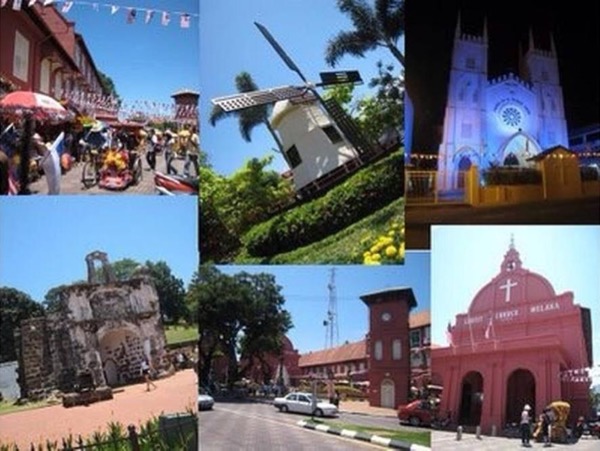image: http://www.thestar.com.my/~/media/online/2017/05/21/20/38/metd_2205_9aamela_sd_5.ashx/?w=620&h=413&crop=1&hash=B025D317947BE11731F061A3F0D233110366568A
When the first traffic lights were introduced in Melaka in the second half of last century, at the intersection of Bunga Raya and Newcome Roads, people from outlying areas would congregate there just to watch the lights change.
SQUALOR. Gambling. Opium. Prostitution. All these made up the vices along Jalan Bunga Raya, Melaka, in its history until the 1970s.
If you stand at one end of Jalan Bunga Raya, with Discovery Cafe on your left and Taj Grand Hotel on your right, this is where wealthy Chinese merchants used to live.
A lot of the two-storey colonial buildings still maintain the original architecture, with the iconic big windows and wooden shutters.
These old-style houses comprise shops on the ground floor and residence upstairs.
“During Chinese New Year, I used to hang out with my classmates on the balcony and we would throw live fire crackers down to the road.
“It was fun and no one took offence. But that was then,” reminisced heritage enthusiast Colin Goh, a sprightly Melaka-born in his 70s.
The Bunga Raya area was a domain for fishermen and it was populated by Javanese people during the Sultanate period at the turn of the 14th century. During the Portuguese era, it mainly comprised orchards and coconut groves.
After the Dutch drove the Portuguese out of Melaka in 1641, they started kilns for making clay bricks and lime plaster in this suburb.
Today, as you walk along Jalan Bunga Raya, you can see some of the dark orange bricks from the etched out laterite stone walls, a symbol of the Dutch-Portuguese era and more importantly, how old the structures and materials are.
Towards the last quarter of the 19th century, Jalan Bunga Raya changed slowly. Melaka as a whole emerged from its slow-paced life.
Its tourism draw has lessened when compared to other places such as Penang and Singapore.
“With the advent of the rubber industry, things began to look better. Bunga Raya saw urban renewal,” said Goh.
Before we proceeded further down memory lane, Goh introduced me to one of his favourite (and many Melaka-born people) shops – Tai Chong Ice Cafe for some Sweet Corn Ice with Milk. As it was a stifling hot day, a bowl of this was a respite.
“As far as I know, people returning to Melaka make their pilgrimage to this shop for local desserts. It’s a sentimental thing,” he said. Ice cream and ice desserts here cost no more than RM4.
“Tai Chong is a well-known name in the area for the ice cafe as well as baking goods shop and stationery shop. There are many wall columns embossed with Chinese calligraphy and dates like ‘1911’, probably symbols of ownership from the wealthy businessmen.
“These Chinese gentlemen became wealthy from rubber trades. They helped the city prosper through philanthropy. One of them was Tan Kim Seng who had a bridge named after him near Jalan Bunga Raya.
“Melaka did not receive much funding for developments from the British government then. There were hardly any development compared to George Town and Singapore,” said Goh.
The British occupied Melaka from 1795 to 1818 and from 1824 until the country celebrated its independence in 1957.
“You can also see that the rows of houses, built during the British period, have narrow walkways that serve as ‘fire break lanes’.
The part of Jalan Bunga Raya that was notorious for vice was Jalan Java (Kampung Java).
“Today, it is fashionable (for tourists) to stay here. But in its earlier days, it was seedy with gambling, opium trade and prostitution,” Goh said.
The whole street is somewhat charming, as we passed by Sin Hiap Hin liquor shop, which is more than 80 years old.
There was also a story circulating that some of the Japanese who resided in Jalan Bunga Raya in the 1930s were spies.
Some locals believe they came to Melaka on the pretext of securing jobs as dentists and photographers, when in fact they were spies for the Japanese government.
“During the Emergency, Europeans patronised the famous Asia Hotel along this road which was known for its opium dens and prostitution,” said one local who did not want to be named.
There are plenty of stories about the heyday of Jalan Bunga Raya and you are bound to find someone from here to regale you further.
Read more at http://www.thestar.com.my/metro/focus/2017/05/22/a-place-with-over-500-years-of-history-melakas-jalan-bunga-raya-has-seen-the-rise-and-fall-of-severa/#lybWKzfCrczrF61m.99

No comments:
Post a Comment